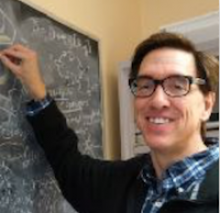Eukaryotic cells (the cells that make up me and “eu”) have an alien technology that is largely mysterious to us. By that I mean that cells function along principles that are quite different from our own technologies. Recently, a striking shape was glimpsed in the inner reaches of these cells — the so-called Terasaki ramps. This shape looks like a helical ramp connecting a stack of parallel layers, something like a multi-level parking garage. Finally, a design principle we recognize! Yet, surprisingly, very similar shapes are found in computer simulations of dense nuclear matter, the type of matter expected to occur in the crusts of neutron stars — this despite the fact that nuclear matter is 14 orders of magnitude denser than matter in our cells, and that it is a consequence of the strong interaction governing protons and neutrons. Nonetheless, the very similar structures suggest that both systems may have similar dynamics and that the shapes are indeed determined by geometry, independent of microscopic details. I’ll discuss these mysterious connectors and connections and whether they can used to understand both new intracellular shapes as well as new phenomena in the crusts of neutron stars.

